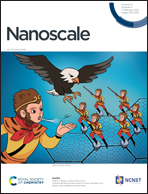Unprecedented enhancement of wear resistance for epoxy-resin graphene composites†
Abstract
Epoxy resins (ERs) have extraordinary mechanical, electrical and chemical properties, and are widely used in the aerospace, electronics and marine industries. Nonetheless, solidified ERs have intrinsic brittleness and low wear resistance. Until now, the promotion of the wear resistance of ER is limited to 30 times, through blending from one to four reinforcing materials. Therefore, it has been a challenge to enhance the wear resistance of ER to over 30 times. Additionally, mechanisms to improve the tribological properties of polymer composites are elusive. In this study, novel ER/graphene composites (ECs) were developed, and the wear resistance of EC with 5 wt% graphene (EC5) was shown to be 628 times that of pure ER at 10 N. To the best of our knowledge, the unprecedented enhancement of wear resistance for ER is the highest reported. The enhancement mechanisms of graphene reinforcement to ER were determined by molecular dynamics simulations. When the content of graphene reaches 5 wt%, exfoliated graphene flakes adhere the most on the surface of a stainless-steel ball during sliding tests, reducing the wear most effectively. However, when the content of graphene is over 5 wt%, graphene flakes accumulate inside the composites, and less exfoliated graphene flakes adhere to the surface of the ball during sliding, increasing the wear. The developed binary ECs are light-weight and cost-effective and have minimal impact on the environment. This composite has many potential applications for high-performance components used in the aerospace, electronics and marine industries.

- This article is part of the themed collection: 2021 Nanoscale HOT Article Collection


 Please wait while we load your content...
Please wait while we load your content...